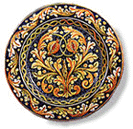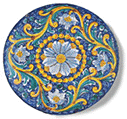Sicilian Ceramic Art - Majolica - Pottery (original) (raw)
Home Page Site Search Sights & Activities Localities • Places Good Travel Faqs Sicily's Top 12 Hotels • Planning Maps of Sicily Weather • Climate Nature • History • People Food • Wine • Dining Arts • Literature • Culture Monthly Magazine Sicilian Identity Sicily Links Contact • Follow
 See Sicily with one of our guided Sicily tours almost any week of the year. Enjoy an interesting, well-planned itinerary with a small group and just 2 or 3 hotel check-ins. Fascinating sights and great cuisine await you. We offer more start dates for tours of Sicily than any other company in the world, and our travel specialists based _in Sicily_will arrange details like airport pick-up and extra nights before or after your tour. Visit our page for itineraries, details, conditions and plenty of FAQs and other information.
See Sicily with one of our guided Sicily tours almost any week of the year. Enjoy an interesting, well-planned itinerary with a small group and just 2 or 3 hotel check-ins. Fascinating sights and great cuisine await you. We offer more start dates for tours of Sicily than any other company in the world, and our travel specialists based _in Sicily_will arrange details like airport pick-up and extra nights before or after your tour. Visit our page for itineraries, details, conditions and plenty of FAQs and other information.
Sicilian Ceramic Art
The Sicilian ceramic master's craft is deeply rooted in time. This timeless art has flourished for millennia, perfectly expressing the essence of Mediterranean culture. Shapes, colours and motifs born of a profound respect for the past with an eye to the future. Terra cotta harvested from the earth and caressed by the Sicilian sun.
A Piece of Sicily Like any other unique work of art, a ceramic piece begins with an idea. That idea is the vision of an individual artist. Then there's the material. The clay found in each region of the world is unique. Sicilian clay, used in terra cotta earthenware over the millennia, is different from the clay of Mexico or Mongolia because it contains a combination of silicates unique to Sicily. This clay, freshly mined from the Sicilian mountains and valleys, is molded by hand by ceramic masters, and then left to dry under the sun.
Like any other unique work of art, a ceramic piece begins with an idea. That idea is the vision of an individual artist. Then there's the material. The clay found in each region of the world is unique. Sicilian clay, used in terra cotta earthenware over the millennia, is different from the clay of Mexico or Mongolia because it contains a combination of silicates unique to Sicily. This clay, freshly mined from the Sicilian mountains and valleys, is molded by hand by ceramic masters, and then left to dry under the sun.
The object is then painstakingly painted in ornate motifs with rich glazes before being fired (baked) in a kiln. During this last phase of creation, something miraculous happens. In the heat, the sun-dried clay hardens to become terra cotta and then crystallizes into ceramic. Its molecular structure changes, becoming firmer but also more durable. The glazed enamel also crystallizes, actually binding to the ceramic as it assumes a deeper, more distinct color.
There are, of course, various decorative ceramic products made in Sicily and sold around the world. Bearing whimsical or even gaudy motifs, these products are sometimes signed with an artist's name but actually painted by generic workers, many of whom aren't even Sicilian. Finding ceramic art that reflects Sicily's true artistic heritage isn't always easy. You may have to search for it. Caltagirone, Santo Stefano di Camastra and Monreale are Sicily's most famous ceramic centers.
A Ceramic Choice Ceramic, terra cotta, maiolica, china, porcelain. What do these terms really mean, and how will understanding them help you to choose the ceramic art that's right for you?
Ceramic, terra cotta, maiolica, china, porcelain. What do these terms really mean, and how will understanding them help you to choose the ceramic art that's right for you?
The most important factor in making your selection is a matter of purely personal taste - but keep lead content in mind (see note below). Simply a question of what you like and what you think will look good in your home or office - or the home of the special person who receives the unique gift of Sicilian ceramic art. Aesthetics aside, the eclectic world of ceramic art is a fascinating place where artistic dreams become precious family heirlooms.
To many of us, the very word "ceramic" conjures images of plain wall tiles like the ones in our kitchens. The word "ceramics" brings to mind molded clay articles sold in craft shops. While neither perception is actually incorrect, each reflects only a very small facet of the world of ceramics. In its most general sense, "ceramic," from the Greek keramos (potter's clay), describes a vast array of artistic techniques leading to the creation of items fashioned from hardened or baked clay.
By Any Other Name Terra cotta (Italian for "baked earth") is a process of baking or partially baking clay objects to make them brittle and water-resistant. Known as earthenware, the clay pottery of ancient Egypt was terra cotta of this type. Since the color and chemical composition of clay varies from place to place, depending on its "clay minerals" (such as silicates), the earthenware of Persia was a different substance from that of Spain.
Terra cotta (Italian for "baked earth") is a process of baking or partially baking clay objects to make them brittle and water-resistant. Known as earthenware, the clay pottery of ancient Egypt was terra cotta of this type. Since the color and chemical composition of clay varies from place to place, depending on its "clay minerals" (such as silicates), the earthenware of Persia was a different substance from that of Spain.
When the clay is fully baked (fired) at a higher temperature, resulting in an opaque material, it is referred to simply as "ceramic" or "stoneware." If the clay is mixed with feldspar or steatite before baking, the resulting ceramic material is known as porcelain. In general, ceramic is a shade of brown or "terra cotta" even after firing, and somewhat coarse (granular) in consistency. Porcelain is usually rather translucent, with a white or gray color and a more refined (less granular) texture.
As its name implies, the porcelain known as "china" was originally made exclusively in China. The best known European porcelain is called Capodimonte, after the Italian town where it is still made today. Porcelain is a form of ceramic, but not all ceramic is porcelain.
Majolica, from the Italian for "Majorca," refers to the form of ceramic earthenware made in Italy that is painted with tin oxide glazing enamels before being fired to a reflective, durable finish. Most of the ceramic art sold in Sicily today is majolica. However, "majolica" (or maiolica) is a rather recent term.
Since the Dawn of History To discover the origins of Sicilian ceramic art we must look to the dawn of the island's history. The Sicanians, an ancient Sicilian people, were making terra cotta objects more than three millennia ago. Their art was developed further under the conquering Phoenicians and the colonizing Greeks.
To discover the origins of Sicilian ceramic art we must look to the dawn of the island's history. The Sicanians, an ancient Sicilian people, were making terra cotta objects more than three millennia ago. Their art was developed further under the conquering Phoenicians and the colonizing Greeks.
The Romans' arrival in Sicily brought a certain Etruscan influence to the Sicilian ceramic masters' art. In the Middle Ages, Byzantine and then Saracen (Moorish) styles and techniques made their influence felt. Sicily is said to be the most conquered island in the world. Not surprisingly, therefore, each of a dozen civilizations have left their mark on its art. It was probably the thirteenth-century Spaniards of Aragon who first referred to colored Sicilian ceramic objects as "maiolica" because the glazing and firing techniques used to create these pieces were similar to those used on Majorca, the largest of the Balearic Islands. This was a logical choice of terms, since it was the Moors who brought majolica to both Sicily and Spain.
One of the things that made medieval maiolica so obviously different from the terra cotta stoneware of the ancient Greeks was its glazing technique. The glazes used in majolica are usually viscous tin oxide colors applied over a white imprimatura ("ground"). Apart from its chemical composition, the characteristic that makes majolica different from porcelain is its relatively low firing temperature. Majolica was probably introduced into the Arab world sometime during the ninth century, around the time the Moors conquered Sicily. This early majolica probably reflected the Arabs' attempts to reproduce Chinese (and Mongolian) porcelain; the painted white ground may have been an effort to duplicate porcelain's naturally light color. In the Mediterranean world, the result was majolica, an art that may be said to combine the best features of both terra cotta and porcelain.
Editor's Note: You may have noticed that we do not mention Sicilian ceramists by name. One reason for this is that we don't wish to endorse one over the other. But there's another reason: Unfortunately, the better-known firms that sell Sicilian ceramics offer items of inferior quality which, as we mentioned earlier, are manufactured by low-cost labour rather than real craftsmen and artists. An artist's name on a decorative ceramic work is no guarantee that he or she created it, and in our experience the best ceramic artists in Sicily are those who are virtually unknown. They're worth seeking.
U.S. Import Notice: United States Government Import Alert (number IA5208) presently restricts the import, even in small quantities, of certain ceramic items which contain a high lead content deemed unsafe. We've received emails from Americans who purchased such objects only to have these confiscated upon arrival in the United States. The restriction currently applies to glazed ceramic items sold by at least one Sicilian firm, based in Palermo.